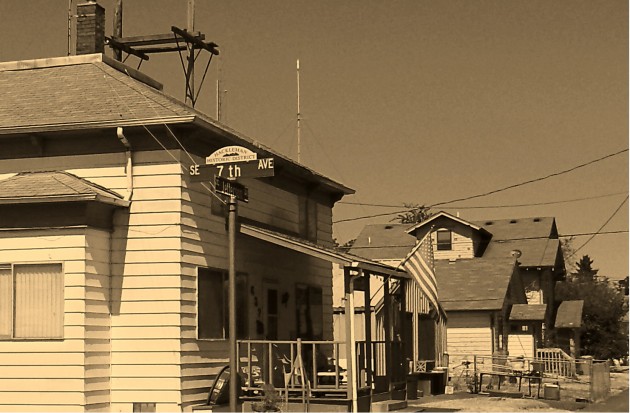Albany’s downtown renewal program hopes that loans of a few thousand dollars will encourage people to buy severely blighted houses dating from 1945 or earlier in the east-side historic district, spend at least $40,000 on renovations, and commit themselves to live there as owners. And if they wanted to renovate the exterior, they’d have to get the city’s landmarks commission’s OK. Sound enticing?
The majority of the Central Albany Revitalization Area’s advisory board thinks so. The board voted last week to reathorize a “Historic Homebuyer Loan Program” it had first agreed to launch in November 2013. It set aside $80,000 a year for the program, and board Chairman Rich Catlin said he hoped it would be in effect for at least five years.
The program is limited to the Hackleman Historic District east of Lyon Street and houses built there before 1946. The idea is to encourage renovation and home ownership in the district, where some old houses have been restored but many others need work or have been turned into apartments.
Under the program, buyers of delapidated houses, or houses they want to return to single-family residency, can apply for loans of up to 20 percent of the cost of renovations on projects costing at least $40,000. At that rate, the amount allocated would cover 10 applications for loans of $8,000 per year. The loan money could also be used to pay city fees.
Even though the CARA board approved it a year and a half ago, the program wasn’t ready to get started till now because of lack of staff time, the board was told. But now, urban renewal manager Kate Porsche has hired a young helper, Nathan Reid, who presented the program to the board last Wednesday. He now plans to tell real estate agents about the loan possibilities.
Mark Spence and other CARA board members expressed some degree of frustration about the slow progress of CARA activities. City Manager Wes Hare took the blame because he had added to Porsche’s job by making her the city’s economic development director as well. (hh)




CARA presumably markets itself as “a rising tide that lifts all boats” in the downtown area.
So one expected outcome of these low interest loans is to raise the market value of all privately owned property in the CARA area.
I wasn’t at the CARA meeting, so I’m wondering.
Did the CARA Board members who own property within the CARA area declare a conflict of interest before voting on this program?
If yes, I’d like to thank them for their honesty.
If not, why not?
That “rising tide” (and “expected outcome”) affects all of Albany.
I live in Albany – it will affect my property taxes too. You’re welcome.
Any other insinuation is simply your continual flogging of a program you disagree with. Nothing to see here folks, move along…
Gordon, fabricating nonexistent, unsourced speculation insinuating violations of the law against elected officials seems to be the only skill you have.
Except when you do the same thing aga
inst government employee too. Didn’t you spend pretty much your entire adult life employees by government operations?
“Methinks you doth protest too much” – Shakespeare
According to the city’s website, CARA will produce a $230 million increase in the market value of private properties in the CARA area.
Doesn’t a CARA Board member who owns property in the CARA area reap some of that $230 million financial gain by supporting a spending project? Isn’t that a conflict of interest?
There is plenty to see here, if you take your blinders off…
More lies Gordon. Where is your proof? You NEVER seem to have any.
Jut your twisted mind at work again. Time for you to scurry back to the shadows.
“…..can apply for loans of up to 20 percent of the cost of renovations on projects costing AT LEAST $40,000. At that rate, the amount allocated would cover 10 applications for loans of $8,000 per year.”
Hasso- The projects have to be a $40,000 MINIMUM.
There is no MAXIMUM stated that I see. One project could conceivably use up the entire amount.
Under CARA Funding, the recipient can only receive $8,000-$20,000- and up to 20% of the project costs. This can either mean ten smaller $8,000 loans, four $20,000 loans, or any number in between.